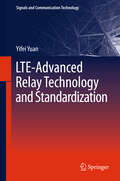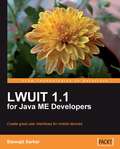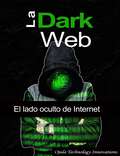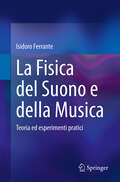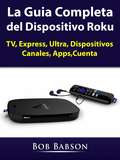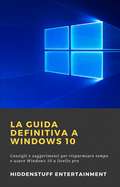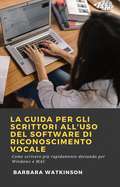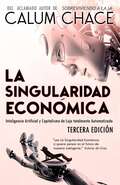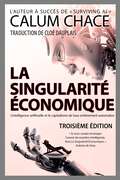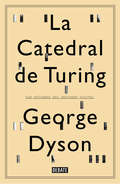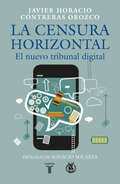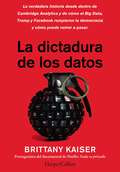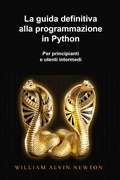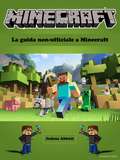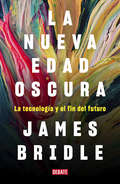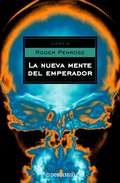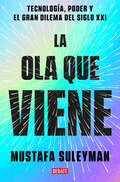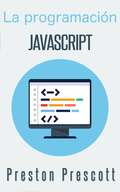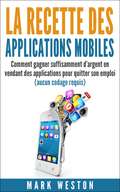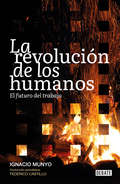- Table View
- List View
LTE-Advanced Relay Technology and Standardization
by Yifei YuanLTE-Advanced relay technology and standardization provides a timely reference work for relay technology with the finalizing of LTE Release 10 specifications. LTE-Advanced is quickly becoming the global standard for 4G cellular communications. The relay technology, as one of the key features in LTE-Advanced, helps not only to improve the system coverage and capacity, but also to save the costs of laying wireline backhaul. As a leading researcher in the field of LTE-Advanced standards, the author provides an in-depth description of LTE-A relay technology, and explains in detail the standard specification and design principles. Readers from both academic and industrial fields can find sections of interest to them: Sections 2 & 4 could benefit researchers in academia and those who are engaged in exploratory work, while Sections 3 & 4 are more useful to engineers. Dr. Yifei Yuan is the Technical Director at the Standards Department of ZTE Inc.
LWUIT 1.1 for Java ME Developers
by Biswajit SarkarThis book presents LWUIT through an optimum mix of theory and practice. Classes are described and their applications are demonstrated through a large number of examples. Example code is thoroughly analyzed and many screenshots are included to show what happens when the code is executed. Custom classes are built progressively with a thorough explanation of each step. The book also presents the underlying structural features of LWUIT that are important for skillful use of the API This book is for Java ME developers who want to create compelling user interfaces for Java ME applications, and want to use LWUIT to make this happen
La Dark Web: El lado oculto de Internet
by Ojula Technology InnovationsEl libro actualizado sobre Dark Web y Dark Net. Debe leer este libro si desea aprender o embarcarse en el viaje de la web oscura. En este breve libro, aprenderá las historias escalofriantes de la web oscura y la red oscura. Conocerá los fundamentos, los hechos y las cifras sobre la web superficial, la web profunda y la web oscura. El libro también ofrece una amplia visión general de las amenazas digitales y los delitos informáticos actuales y emergentes. Se le actualizará con información crucial sobre el fraude y el robo de identidad que se llevan a cabo diariamente en la web oscura. En concreto aprenderás: ¿Qué es exactamente la web oscura? El origen de la deep web y la dark web. Actividades que tienen lugar en la dark web Cómo te afecta la dark web. Cómo se venden los datos personales en la dark web Los datos que se comercializan con mayor frecuencia en la dark web Servicios de tráfico de órganos humanos y pornografía infantil en la dark web Los mercados de la web oscura La red Tor y cómo funciona el navegador Tor La historia de Ross William Ulbricht, el hombre detrás de la Ruta de la Seda La verdad sobre Surface Web: por qué no se puede confiar en algunos sitios con su información. Lo más importante que aprenderás: Qué puede hacer para protegerse de actividades maliciosas en la dark web Cómo mantener segura su identidad en Internet a diario.
La Fisica del Suono e della Musica: Teoria ed esperimenti pratici
by Isidoro FerranteQuesto volume raccoglie e sviluppa i materiali elaborati negli anni per le lezioni dimostrative e divulgative tenute dall'autore presso i licei della Toscana e della Calabria, nonché nei corsi di aggiornamento per docenti organizzati dall'Università di Pisa, dall'INFN di Pisa e dal master IDIFO dell'Università di Udine. Il testo tratta di acustica, con particolare riferimento alla fisica della musica e al funzionamento degli strumenti musicali. L'approccio è di tipo "hands on": per ogni argomento vengono proposti esperimenti molto semplici da effettuare a casa, con poca o nessuna abilità manuale e attrezzatura economica o addirittura a costo zero. Viene anche proposta la costruzione "scientifica" di semplici strumenti musicali come il flauto di Pan, la glassarmonica e la kalimba. Il livello è concepito per essere più agile e divulgativo, rivolgendosi a un pubblico ampio con un minimo di background scientifico. Il libro può essere un valido complemento anche per gli insegnanti di fisica nei licei musicali e i loro studenti, che potrebbero trovare spunti utili per le attività di laboratorio. La maggior parte degli esperimenti descritti utilizza un computer dotato di scheda audio e del programma di registrazione ed editing sonoro Audacity. Audacity è stato scelto perché è un programma gratuito, open source, attivo da diversi anni e con la prospettiva di rimanere aggiornato ancora a lungo.
La Guia Completa del Dispositivo Roku: TV, Express, Ultra, Dispositivos, Canales, Apps,Cuenta
by Bob BabsonGuia para Usuarios Roku. Esta guia le mostrará algunos consejos para usar su dispositivo Roku ademas de todos los beneficios con los que cuenta al haberlo adquirido.
La Guida Definitiva a Windows 10: Consigli e suggerimenti per risparmiare tempo e usare Windows 10 a livello pro
by Hiddenstuff EntertainmentCome per Windows 7 e 8.1, ci sono state alcune nuove aggiunte nell’ambito del tipo di funzionalità disponibili su Windows 10. A volte, però, è difficile adattarsi a una nuova tecnologia, perciò ecco 9 consigli e suggerimenti per fare in modo che, con Windows 10, il tuo PC funzioni come vuoi tu.
La Guida per gli Scrittori All'uso del Software di Riconoscimento Vocale: Come scrivere più rapidamente dettando per Windows e MAC
by Barbara WatkinsonSapevi che i software per la dettatura possono aiutarti a scrivere un libro fino a 3 volte più rapidamente? Vuoi riuscire a scrivere un romanzo in modo più rapido ed efficace? Se hai risposto di sì, allora questa pubblicazione fa al caso tuo! Questa guida è farcita di una miriade di strategie per dettare un romanzo comodamente dal tuo salotto e senza toccare la tastiera! Ecco gli argomenti trattati del libro: Come iniziare Come preparare una bozza Le migliori applicazioni per la scrittura vocale Come usare il software per la dettatura per pubblicare un romanzo e MOLTO ALTRO! Se vuoi imparare a scrivere un romanzo dettando, allora questo libro fa per te! --> Vai in cima alla pagina e clicca su aggiungi al carrello per acquistarlo subito Disclaimer: L'autore e/o il titolare o i titolari dei diritti non danno alcuna certezza, non fanno alcuna promessa e non forniscono alcuna garanzia sulla precisione, sulla completezza o sull'adeguatezza dei contenuti della presente opera e declinano espressamente la responsabilità per qualsiasi errore e omissione nel suo contenuto. Questo prodotto è destinato al solo utilizzo come riferimento.
La Singularidad Económica: Inteligencia Artificial y Capitalismo de lujo totalmente automatizado
by Calum ChaceLa singularidad económica tendrá lugar en el momento en que la mayoría de las personas no pueda encontrar empleo, porque las máquinas puedan hacer todo lo que los humanos pueden hacer por dinero a un menor costo, más rápido y mejor que ellos. Algunos dicen que esto nunca sucederá, pero la mayoría de los profesionales de la IA creen que sí, aunque no se ponen de acuerdo cuándo. La inteligencia artificial (IA) ya sobrepasa a los humanos en absorber y procesar información. Los robots se están volviendo cada vez más diestros, flexibles y seguros (excepto los militares). La IA es nuestra tecnología más poderosa y debemos comprenderla. Esta tercera edición del libro más vendido de Calum Chace se ha actualizado y ampliado sustancialmente. Sostiene que la singularidad económica es el desafío más importante que enfrentará la humanidad en la primera mitad del siglo XXI, y también su oportunidad más interesante. Los coches autónomos y los teléfonos inteligentes con los que puedes conversar pueden ser los canarios en la mina de carbón, lo que brinde una llamada de atención para todos aquellos que aún dudan de su inminencia. Todos los trabajos se verán afectados, desde los empleos de comida rápida hasta abogados y periodistas. La popular creencia de que la Renta Básica Universal es la solución es sólo parcialmente correcta. Probablemente vamos a necesitar un sistema económico completamente nuevo, y pronto deberíamos comenzar a planificar para prepararnos para la Singularidad Económica. Chace sostiene que el resultado puede ser muy bueno: un mundo en el que las máquinas hacen todos los trabajos aburridos y los humanos hacen prácticamente lo que les place. Pero advierte que existen grandes riesgos, que solo podemos evitar estando alerta a los posibles futuros y planificando cómo evitar los negativos. Chace ha estado escribiendo sobre IA desde 1980 y ha escrito dos libros de no ficción muy vendidos y también dos novelas sobre el tema. En 201
La Singularité Économique: L'intelligence artificielle et le capitalisme de luxe entièrement automatisé
by Calum ChaceLa Singularité Économique La singularité économique désigne le moment où la majorité de la population se retrouvera au chômage, car les machines pourront accomplir toutes les tâches humaines plus rapidement, plus efficacement et à moindre coût. Si certains affirment qu’elle est impossible, beaucoup de spécialistes en IA l’envisagent, même s'ils divergent sur l’échéance à laquelle elle surviendra. L'Intelligence Artificielle (IA) est déjà plus performante que l'humain dans sa capacité d'assimilation et de traitement de l'information. Les robots deviennent de plus en plus habiles, flexibles et sécurisés (à l'exception des robots militaires). L'IA est la plus puissante de nos technologies, il est devenu vital de la comprendre. Cette troisième édition du best-seller de Calum Chace bénéficie d'une mise à jour et d'une extension substantielles. Il affirme que la singularité économique constitue le plus grand défi de l'humanité de la première moitié du XXIe siècle, mais aussi l'opportunité la plus prometteuse. Les voitures autonomes et les smartphones avec lesquels il est possible de dialoguer sont sans doute « les canaris dans la mine de charbon », qui tireront la sonnette d'alarme pour tous ceux qui n'y prêtent pas encore attention. Tous les métiers seront concernés, des McJobs de la restauration rapide, aux avocats et aux journalistes. La tendance à croire que le Revenu de Base Universel soit la solution idéale n'est que partiellement correcte. Nous aurons vraisemblablement besoin d'un tout nouveau système économique. Nous devons commencer dès maintenant à nous préparer à la Singularité Économique. Selon Chace, elle pourrait avoir une issue très positive. Nous pourrions vivre dans un monde où les machines se chargent de toutes les tâches ennuyeuses et où les humains font ce qui leur plaît. Mais il met en garde contre les risques majeurs, que nous ne pourrons éviter qu
La bocina del hogar
by Adidas WilsonEl presente libro no da una gran ilustración del cómo podemos manejar de manera más fácil nuestro hogar de forma inteligente, la bocina del hogar, que se ha convertido en esa útil herramienta tan esencial para llevar a cabo las tareas más básicas del hogar, como encender luces, encender el radio en la estación favorita, transmitir y escuchar la misma música en dos o más habitaciones del hogar, encender y apagar los electrodomésticos en fin, se prevé que será un exito, y sobre todo porque es la pauta a seguir para mejorar las tareas automátizadas en el hogar.
La catedral de Turing: Los orígenes del universo digital
by George Dyson«Es posible inventar una sola máquina que pueda utilizarse para computar cualquier secuencia computable», anunció en 1936 un joven Alan Turing de veinticuatro años. En los años 40 y 50 un reducido grupo de hombres y mujeres, liderado por John von Neumann, se reunió en Princeton, New Jersey, para comenzar la construcción de una de los primeros ordenadores que materializaría la visión de Alan Turing de una máquina universal. Los códigos generados en ese embrión de universo de 5 kilobytes (menos memoria de lo que requiere un solo icono en la pantalla de un ordenador actual) rompieron la distinción entre números que significan cosas y números que hacen cosas, y nuestro universo cambió para siempre. La catedral de Turing es la historia de la invención más constructiva del siglo XX, el ordenador digital, de quiénes y cómo la crearon. Un relato histórico y profético que nos cuenta cómo el código logró conquistar el mundo y se aventura a plantear el futurodel universo digital."No es solo un libro extraordinario sobre ciencia. Es un libro extraordinario, punto." #The Globe and Mail «Si quieres estar mentalmente preparado para la próxima revolución informática, el libro de Dyson es imprescindible. Pero también es imprescindible si solo quieres una historia apasionada de cómo los científicos de verdad (como mínimo algunos) piensan y trabajan.» Literary Review
La censura horizontal: Un nuevo tribunal digital
by Javier Horacio Contreras Orozco«Javier Contreras ha escrito un libro excepcional y necesario en estos tiempos de tecnologización de la vida pública.» Ignacio Solares Hoy en día las redes sociales son mucho más que simples herramientas de entretenimiento, información y socialización: una parte de nuestras vidas transcurre dentro de ellas. Han ampliado nuestra capacidad de comunicación de forma inaudita, le han dado voz a personas que antes no la tenían y, sobre todo, permiten que la información fluya con una velocidad y en volúmenes sorprendentes. Sin embargo, estas características no han hecho de las redes sociales los espacios de diálogo y tolerancia que esperábamos de ellas. Por el contrario, con frecuencia las hemos visto convertirse en la gran hoguera del siglo xxi. En este libro, Javier Horacio Contreras Orozco analiza las condiciones y procesos que han llevado a las redes sociales a constituirse en un jurado universal que ejerce un nuevo tipo de censura: la poscensura o censura horizontal. A diferencia de la censura tradicional, que provenía de los gobiernos o de poderosos intereses privados, la censura horizontal es un sistema de vigilancia y silenciamiento entre pares. Un tribunal sin juez o, mejor dicho, en el que todos son jueces, pero en el que también todos pueden ocupar el banquillo de los acusados de un momento a otro. Al excluir a una gran cantidad de voces del debate público, la censura horizontal contribuye a la pandemia de desinformación que caracteriza nuestros días. Es uno más, como advierte Contreras Orozco, de los síntomas de la era de la posverdad.
La construcción de la esperanza
by Ignacio MunyoReflexiones sobre las fortalezas y mejoras para el Uruguay del futuro. La esperanza es una combinación entre la realidad y un objetivo deseado. La realidad de Uruguay en la actual coyuntura global y regional nos permite ser optimistas. El objetivo deseado surge del análisis de nuestras posibilidades, de nuestras fortalezas y mejoras necesarias, con base en evidencia y no en prejuicios. Sueño despierto con ese objetivo. Ha sido clave paraello haber mirado de cerca varios casos de países que lograron elevados niveles de bienestar económico sustentable desde el punto de vista social y ambiental. También ha sido clave conversar con muchas personas, con una multiplicidad devisiones, que impulsan las más diversas corrientes de opiniónen Uruguay. Este libro, que pretende ser un conjunto ordenado de reflexiones procesadas a lo largo de muchos años, busca contribuir a la construcción colectiva de la esperanza, que creo que necesita Uruguay para cumplir con su destino ineludible: ser un gran país, moderno, desarrollado, de primera línea eintegrado al mundo. Mirar más alto se puede, y se debe. La esperanza se construye. Primero, internamente, luego, públicamente, para que sea la semilla de un sueño colectivo.
La dictadura de los datos: La verdadera historia desde dentro de Cambridge Analytica y cómo el Big Data, Trump y Facebook corrompieron la democracia, y cómo puede volver a pasar
by Brittany KaiserBrittany Kaiser, una ex directiva de Cambridge Analytica, la empresa que se dedicó durante años a manipular procesos electorales en numerosos países del mundo, cuenta cómo fue que Facebook y las transnacionales de internet torcieron el proceso electoral en el que Donald Trump ganó la Presidencia de Estados Unidos.Ella revela cómo las políticas laxas de Facebook y la falta de leyes nacionales permitieron que los votantes fueran manipulados tanto en Gran Bretaña como en los Estados Unidos, donde se adjudicaron datos personales para difundir noticias falsas y mensajes racistas durante la votación del Brexit y la elección estadunidense de 2016. Pero el daño no ha terminado, advierte Kaiser. La elección de 2020 también puede verse comprometida.Kaiser tomó la difícil decisión de exponer la verdad arriesgando su carrera, sus relaciones y su seguridad personal. Habló a las autoridades sobre las prácticas comerciales poco éticas de la industria de los datos, y finalmente testificó ante el Congreso de los Estados Unidos, ayudando a la investigación del abogado Robert Mueller sobre la interferencia de Rusia en las elecciones de 2016, junto con al menos otras 10 investigaciones internacionales.Repleto de historias e ideas nunca antes contadas públicamente, Kaiser aboga por la regulación, argumentando que la supervisión legal de la industria de los datos no solo es justificable, sino esencial para garantizar la seguridad a largo plazo de nuestra democracia.
La escuela de WordPress de 5 días: cómo convertirse en un diseñador de sitios web de WordPress en 5 días o menos
by Cyrus M. Jackson¿Le encantaría aprender cómo configurar (fácilmente), diseñar (profesionalmente) y asegurar (adecuadamente) los sitios de WordPress que matan (incluso si no tiene conocimientos previos de codificación o temas técnicos)? Entonces, ¡la "Escuela de WordPress de 5 días" es la guía más autorizada que necesitarás! Ya no es una novedad que WordPress es la mejor plataforma de blogs del planeta y el sistema de administración de contenido más popular que puede encontrar hoy en día, que controla el 52% de los sitios web en Internet (según Technorati) que habla sobre el volumen de su eficiencia y sus increíbles funciones. No es de extrañar que los sitios web autorizados en Internet (como CNN, New York Times, HuffingtonPost, Mashable ...) estén basados en la plataforma WordPress. WordPress es la bomba: ¿quieres quedarte fuera? Cyrus Jackson, un diseñador profesional de WordPress, lo lleva de la mano sobre cómo dominar la plataforma de WordPress de manera efectiva: desde la configuración, hasta el diseño, la seguridad ... de una manera de ladrillo a ladrillo con abundantes ilustraciones, capturas de pantalla. , gráficos y pautas paso a paso para brindarle el mapa de ruta necesario sobre cómo configurar su sitio web de WordPress de manera profesional para una audiencia web. Y sí: el libro puede convertirte en un diseñador profesional de WordPress en 5 días, incluso si este es tu primer intento de iniciar una plataforma en línea. ¡En serio! Estos son los temas que se tratan en este libro asombroso, fácil de leer, asombroso y para principiantes: Una explicación detallada de la plataforma de WordPress. Entendiendo el panel de WordPress Configuración de su sitio web de WordPress auto-alojado Todo lo que necesitas saber sobre alojamiento web y registro de dominios. Los mejores servidores web que son fiables y asequibles. Consejos importantes a seguir al elegir un aloj
La guida definitiva alla programmazione in Python per principianti e utenti intermedi
by William Alvin NewtonDescrizione In La guida definitiva alla programmazione in Python per principianti e utenti intermedi imparerete tutti gli strumenti essenziali per diventare esperti nel linguaggio di programmazione Python. Scoprite come installarlo in tutti i principali sistemi operativi: Windows, Mac OS e persino Linux. Sarete guidati passo dopo passo, a partire dal download dei file necessari per effettuare le modifiche nell'installazione per il vostro particolare sistema operativo. Imparate la shell della riga di comando e come utilizzarla per eseguire Python in modalità interattiva e tramite script. Scoprite come funziona l'interprete Python e come usare la shell interattiva della riga di comando attraverso esempi pratici che potrete provare da soli. Imparate in dettaglio i tipi di dati e le variabili, con codici di esempio e la discussione dell'output generato. I numeri sono trattati in dettaglio, compresa una disamina dei 4 tipi di numeri in Python: interi, float, complessi e booleani. Scoprite cosa sono i valori restituiti Truthy e Falsy e come si relazionano con il tipo booleano. Fate esercizio con alcune delle numerose funzioni matematiche integrate in Python, e scoprite la differenza tra le funzioni format() e round(). Le stringhe sono una delle variabili più importanti in qualsiasi linguaggio di programmazione. Imparate in profondità come esplorare, cercare e persino manipolare le stringhe in Python. Fate esercizio con i metodi integrati per le stringhe. Scoprite le strutture di controllo di Python e come utilizzare la logica booleana per ottenere il software che vi serve. Usate gli operatori e capite a fondo i punti di forza e le differenze degli operatori matematici, relazionali e logici, nonché l'importanza della precedenza e dell'associatività tra gli operatori. Scoprite le stringhe e i molti modi per farvi ricerche e manipolarle. Scoprite il potere dell'ereditarietà e del polimorfismo.
La guida non-ufficiale a Minecraft
by Joshua Abbott Loris Palmitesta*GUIDA NON UFFICIALE* In aggiunta all'acquisto di questo eBook potrete segnarvi al nostro programma gratuito in supplemento a questa guida.Copiando il link in basso avrete accesso a tutti gli ultimi update per tutte le app più popolari per videogiochi. Registrati gratuitamente dal link qui in basso: http://emailsignupform.subscribemenow.com/ Consigli Avanzati e Guida strategica. Questa è l'unica guida dettaglia e completa che troverete online. Disponibile subito per il download sul tuo cellulare, su qualunque lettore eBook o in formato cartaceo. Con il successo del mio migliaio di guide e strategie scritte ho deciso di compilare un'altra guida ottima sia per i veterani che per i nuovi giocatori. Questa guida dà consigli specifici su come avanzare nel gioco, sconfiggere i propri nemici, acquisire più monete e ricchezze e tanto altro ancora! Ecco cosa avrai quando acquisterai questa guida professionale avanzata e dettagliata di gioco. - Consigli e strategie da professionista. - Trucchi e Hacks. - Segreti, Consigli, Trucchi e Sbloccabili usati dai Pro Players! - Come ammucchiare tonnellare di monete/soldi. - MOLTO ALTRO ANCORA! Tutte le versioni di questa guida contengono degli screenshot per aiutarti a capire meglio il gioco.Non c'è un'altra guida così completa e dettagliata del gioco. Sarai felice di aver acquistato questa guida e ne trarrai subito grandi benefici se paragonati a quelli che avresti avuto con qualunque altra guida. Acquista adesso e sconfiggi i tuoi nemici! Diventa un Pro Player Adesso! Per supporto e più informazioni su i nostri prodotti perfavore visita il nostro sito: http://www.hiddenstuffentertainment.com/ Disclaimer: Questo prodotto non è associato, affiliato, sponsorizzato o certificato dal Possessore del Copyright Originale.Tutti i marchi e i marchi registrati che appaiono in questo ebook sono di proprietà dei loro rispettivi proprietari.
La nació en portada: El debat de Catalunya i Espanya a la premsa
by Antoni BassasÉs Catalunya una nació? És Espanya plurinacional? Una invitació al debat des d'un periodisme rigorós. El 12 de setembre de 2019, el periodista Antoni Bassas va pronunciar una conferència al Círculo de Bellas Artes de Madrid amb motiu de la festa nacional de Catalunya, que va acabar amb una llarguíssima ovació dels presents i milers de reproduccions posteriors a YouTube. Bassas, una de les veus amb més credibilitat i influència en el panorama informatiu contemporani, hi va presentar una selecció de portades de la premsa de Barcelona i de Madrid dels darrers 40 anys, en un exercici de periodisme comparat que permetia percebre el canvi de tonalitats de la vida social i política a Catalunya i Espanya i que van de l'afirmació nacional catalana a través de l'Estatut d'Autonomia fins al col·lapse de la via estatutària que dona pas a la reclamació del dret a l'autodeterminació, el referèndum de l'1 d'octubre de 2017 i la condemna per sedició dels seus responsables polítics en sentència del Tribunal Suprem el 2019. Ja fa més de quaranta anys que es va aprovar la Constitució i la reivindicació nacional de Catalunya ha acabat per condicionar decisivament l'actuació de tots els actors de la vida institucional espanyola. I Bassas es pregunta: «Si, com repeteixen els mitjans espanyols, el Procés constitueix el desafiament més gran de la història recent d'Espanya i si Catalunya pot posar Espanya de panxa enlaire, no deu ser que no estem davant d'una comunitat autònoma més? I que la recepta no pot ser policies i jutges, sinó la negociació política i el referèndum pactat, com a Escòcia o al Quebec?».
La nación en portada: El debate de Cataluña y España en la prensa
by Antoni Bassas¿Es Cataluña una nación? ¿Es España plurinacional? Una invitación al debate desde un periodismo riguroso. El 12 de septiembre de 2019, el periodista Antoni Bassas pronunció una conferencia en el Círculo de Bellas Artes de Madrid con motivo de la fiesta nacional de Cataluña, que terminó con una larguísima ovación de los presentes y miles de reproducciones posteriores en YouTube. Bassas, una de las voces con más credibilidad e influencia en el panorama informativo contemporáneo, presentó una selección de portadas de la prensa de Barcelona y Madrid de los últimos 40 años, en un ejercicio de periodismo comparado que permitía percibir el cambio de tonalidades de la vida social y política en Cataluña y España y que van de la afirmación nacional catalana a través del Estatuto de Autonomía hasta el colapso de la vía estatutaria que da paso a la reclamación del derecho a la autodeterminación, el referéndum del 1 de octubre de 2017 y la condena por sedición de sus responsables políticos en sentencia del Tribunal Supremo en el año 2019. Hace ya más de cuarenta años que se aprobó la Constitución y la reivindicación nacional de Cataluña ha terminado por condicionar decisivamente la actuación de todos los actores de la vida institucional española. Y Bassas se pregunta: «Si, como repiten los medios españoles, el Procés constituye el desafío más grande de la historia reciente de España y si Cataluña puede poner España boca arriba, ¿no será que no estamos ante una comunidad autónoma más? ¿Y que la receta no puede ser policías y jueces, sino la negociación política y el referéndum pactado, como en Escocia o Quebec?».
La nueva edad oscura: La tecnología y el fin del futuro
by James BridleEntre tanto dato no contrastado, posverdad y fake news, este libro nos alerta y nos empuja a vislumbrar la verdad en esta nueva edad oscura de la información. Cuanto más aumenta la complejidad del mundo tecnológico, más disminuye nuestra comprensión de la realidad: la información que recibimos a diario está plagada de datos no contrastados, de posverdad, de teorías conspirativas... Todo esto nos convierte, cada vez más, en náufragos perdidos en un mar de especulación. James Bridle, el mediático tecnólogo y autor de estas páginas, nos advierte ante un futuro en el que la promesa contemporánea de un conocimiento brindado por la tecnología puede traernos justo lo contrario: una era de incertidumbre, algoritmos predictivos y minuciosos sistemas de vigilancia. Un libro magistral y aterrador que nos adentra en la inquietante tormenta que acecha el debate de las maravillas del mundo digital. Reseñas:«Espero los lectores no disfruten esta perceptiva y sugerente obra, sino que, más bien, sientan pavor.»Will Self, The Guardian «Bridle es un artista y escritor que debate sobre la relación entre tecnología, cultura y conciencia y cuya fama aumenta por momentos. Entre los temas alrededor de los cuales gira su arte están los drones y los coches automatizados. Su nuevo y ambicioso libro presenta cómo la era digital está modificando radicalmente los paradigmas de la experiencia humana.»The Guardian «La obra revela la forma en la que se nos tiene deliberadamente desinformados y cómo estamos adentrándonos de manera inconsciente en un futuro de vigilancia ininterrumpida que nubla nuestros sueños sobre las maravillas del mundo digital.»Financial Times «Un Orwell en la era de la tecnología.»Kirkus Reviews «James Bridle demuestraser un maestro a la hora de encontrar contradicciones en las tecnologías actuales. Este es un libro de extrema importancia en estos tiempos.»Bernard Hay, The Quietus «Un alarmante grito de guerra. El autor es extremadamente convincente al abogar por una interacción más informada con las tecnologías que hemos creado.»Ben Eastham, ArtReview «Una perspectiva firme y una provocación necesaria. Horroroso pero fascinante.»Jamie Bartlett, Spectator «Un libro tan original como provocador.»Pat Kane, New Scientist «Mi ejemplar de este libro está repleto de notas que se amontonan en los márgenes. Me siento como un estudiante de química orgánica que, abrumado, siente la necesidad de subrayarlo absolutamente todo: todo es importante y está conectado y, al mismo tiempo, el autor describe intencionadamente un mundo sin sentido. Denso, absorbente y convincente a más no poder.»Barbara Fister, Inside Higher Education«Este es uno de los libros más perturbadores y reveladores sobre Internet que he leído jamás, lo cual viene a ser lo mismo que decir que es uno de los libros más perturbadores y reveladores que he leído sobre el mundo contemporáneo.»New Yorker «Una tenebrosa puerta que se abre a una nueva era. Una obra escalofriante sobre la oscuridad del mundo digital y los peligros más imprevisibles e imparables que hemos traído al mundo desde el Proyecto Manhattan.»Vice
La nueva mente del emperador: En Torno A La Cibernética, La Mente Y Las Leyes De La Física (Ciencia Y Tecnología Ser.)
by Roger PenroseUn apasionante paseo por la matemática y la física, y por los hallazgos del pensamiento humano. Durante décadas, los defensores de la inteligencia artificial han mantenido que los ordenadores harán pronto todo lo que la mente humana puede hacer. En su favor, se puede utilizar, por ejemplo, el que ya hay máquinas que juegan al ajedrez como los grandes maestros. Ahora bien, ¿comprenden el juego como lo hacemos nosotros? En este libro, Roger Penrose, probablemente el especialista en la teoría general de la relatividad más prestigioso del mundo y una de las mentes analíticas más originales de la actualidad, sostiene que existen facetas del pensamiento humano que nunca serán emuladas por un ordenador. Para defender esa tesis, Penrose recurre a una amplia gama de conocimientos científicos, que van desde la máquina de Turing hasta la estructura del cerebro, pasando por el teorema de Gödel, los agujeros negros y los blancos, la radiación de Hawking, la entropía o la mecánica cuántica. Entre los numerosos estudios existentes dedicados a la relación entre la mente y el cuerpo, esta ambiciosa obra sobresale tanto por su lucidez y claridad como por su rigor y profundidad. Reseña:«Un libro audaz, brillante e innovador. Cuando Penrose habla, los científicos escuchan.»The New York Times Book Review
La ola que viene: Tecnología, poder y el gran dilema del siglo XXI
by Michael Bhaskar Mustafa SuleymanESTAMOS A TIEMPO DE SALVAR EL MUNDO. ESTE LIBRO ES UNA LLAMADA DE ATENCIÓN SOBRE LOS DESCOMUNALES RIESGOS DE LA INTELIGENCIA ARTIFICIAL. «Fascinante, muy bien escrito, importante».Yuval Noah Harari «Una lectura esencial».Stephen Fry Estamos a punto de cruzar un umbral crítico en la historia de nuestra especie. Todo lo que conocemos va a cambiar.Pronto viviremos rodeados de una inteligencia artificial responsable de ejecutar tareas complejas: desde gestionar negocios y producir contenido digital ilimitado hasta dirigir servicios públicos fundamentales o mantener infraestructuras. Habitaremos un mundo de impresoras de ADN y ordenadores cuánticos, patógenos artificiales y armas autónomas, robots asistentes y energía abundante. Todo esto supone una transformación radical en la capacidad humana.No estamos preparados. Como cofundador de la empresa pionera DeepMind, Mustafa Suleyman ha estado en el epicentro de esta revolución llamada a convertirse en el mayor acelerador del progreso de la historia. Asegura que la próxima década estará marcada por esta gran ola de nuevas y poderosas innovaciones de rápida proliferación. Impulsadas por abrumadores incentivos estratégicos y comerciales, estas herramientas ayudarán a afrontar nuestros retos globales y crearán una enorme riqueza, pero también provocarán revueltas a una escala antes inimaginable. En La ola que viene, Suleyman (uno de los mayores expertos del planeta en sistemas inteligentes) demuestra cómo estas fuerzas amenazan seriamente las bases del orden mundial. Mientras nuestros frágiles gobiernos caminan sonámbulos hacia el desastre, nos enfrentamos a un dilema existencial: por un lado, enfrentarnos a los daños sin precedentes derivados de una exposición incontrolada a estas nuevas tecnologías; por otro, a la amenaza de una vigilancia tiránica y abusiva. ¿Conseguiremos abrir un estrecho punto de fuga entre la catástrofe y la distopía? La crítica ha dicho:«Este importante libro es un vívido toque de atención. En él se esbozan cuidadosamente las amenazas y oportunidades asociadas a los estimulantes avances científicos de los últimos años. La ola que viene está repleto de datos interesantes, argumentos fascinantes y observaciones convincentes; es una lectura esencial». Daniel Kahneman, Premio Nobel«El conocimiento de Mustafa Suleyman como tecnólogo, empresario y visionario es esencial... A través de una profunda y muy relevante investigación, este libro ofrece una visiónapasionante de algunos de los retos más importantes de nuestro tiempo». Al Gore, exvicepresidente de Estados Unidos «La revolución de la inteligencia artificial ya está en marcha, pero ¿la conocemos bien? La ola que viene presenta una guía erudita y lúcida tanto de lahistoria del cambio radical que ha supuesto la tecnología como de los profundos retos políticos que nos aguardan». Anne Applebaum «Este libro es inspirador y aterrador al mismo tiempo. Es una lección urgente para quienes no entienden las revoluciones tecnológicas que estamos viviendo y un desafío frontalpara quienes sí las comprenden. Este libro trata del futuro de la humanidad: tenemos que leerlo y actuar en consecuencia». David Miliband, exministro de Asuntos Exteriores del Reino Unido
La programación JavaScript
by Preston Prescott Morena Calaón¿Estás cansado de intentar aprender a programar? ¿Estás listo para conseguirlo? Si ya has intentado aprender a programar, pero no has tenido mucho éxito, entonces dale una oportunidad a La programación JavaScript. Te enseñará exactamente todo lo que tienes que saber sobre cómo utilizar el lenguaje de programación más empleado en todo el mundo. Desde el comienzo, te enseñará lo básico y, a partir de allí, irás fortaleciendo tus conocimientos sobre la base de lo aprendido. Luego no pararás de utilizarlo… Incluso aunque JavaScript sea el lenguaje de programación del lado del cliente más popular de hoy día, también puede emplearse del lado del servidor. Node.js, Meteor, Wakanda, CouchDB, y MongoDB solo son unos pocos ejemplos de entornos donde encontrar y usar JavaScript del lado del servidor. El tiempo que inviertes en aprender JavaScript puede ser doblemente gratificante ya que JavaScript continúa avanzando en más y más áreas de la informática. Si estás buscando avanzar en tu carrera, JavaScript es una valiosa habilidad que puedes incorporar. Este tipo de conocimiento es muy demandado actualmente y esta necesidad no hará más que aumentar. Si deseas abrirte paso en el mercado laboral de la tecnología, ¿qué mejor habilidad para tener en tu currículum que algo que prácticamente puedes usar en cualquier lugar? ¿Quieres trabajar en la parte inicial de los sitios web? Aprende JavaScript. ¿Estás listo para encarar la programación de fondo de las aplicaciones web? Aprende JavaScript. ¿Quieres trabajar con la última tecnología de base de datos disponible? Entonces aprende JavaScript. Pero hazlo de la forma correcta, de una vez por todas. No importa si lo usas del lado del cliente en un navegador web o del lado del servidor. En cualquier caso, o en ambos, tendrás que aprender los fundamentos
La recette des applications mobiles
by Mark Weston Caroline PageauLa révolution des applications mobiles est en cours, alors pourquoi ne pas vous y joindre en téléchargeant votre exemplaire de La recette des applications mobiles dès maintenant! Avez-vous déjà envisagé faire de l’argent en lançant votre propre application? Saviez-vous que c’est facile, peu coûteux et à la portée de n’importe qui? Depuis l’arrivée du iPhone sur le marché en 2007, les applications mobiles sont rapidement devenues le Klondike du monde de la technologie. Si l’on considère les sommes investies pour l’achat de téléphones cellulaires et d’applications mobiles, il n’est pas étonnant que cette industrie produise des millionnaires chaque jour. Je ne suis pas ici pour vous dire que vous ferez fortune en téléversant une application, mais bien pour vous offrir une façon de développer progressivement une source de revenus passive. Dans mon livre, La recette des applications mobiles, je vous montre ce que vous devez faire pour commencer à développer un portefolio d’applications mobiles qui rapporteront jour après jour. Vous avez certainement déjà entendu parler de Angry Birdsou de Plants vs. Zombies? Ce sont des applications mobiles de jeux qui sont devenues des succès commerciaux. Mais nul besoin de créer de tels succès pour tirer un revenu d’une application mobile. Même l’application la plus élémentaire a le potentiel de générer un revenu simplement en raison du nombre de gens qui possèdent un téléphone cellulaire et téléchargent des applications. Dans ce livre, je vous enseigne comment vous pouvez commencer à développer une entreprise d’applications florissante, en profitant du levier extraordinaire que constitue Internet pour lancer une entreprise rapidement et à peu de frais. Vous n’avez même pas besoin de connaissances en codage! En fait, je conseillerais même de vous abstenir de tout codage, à moins d’avoir une idée de génie à laquelle vous tenez mor
La revolución de los humanos: El futuro del trabajo
by Federico Castillo Ignacio MunyoLa cuestión del futuro del trabajo está presente hace años en todos los foros en los que se discuten temas de relevancia global. No es un tema nuevo. Hace mucho tiempo que se viene hablando de la amenaza de la robotización a lo largo y ancho del mundo. La cuestión del futuro del trabajo está presente hace años en todos los foros en los que se discuten temas de relevancia global. No es un tema nuevo. Hace mucho tiempo que se viene hablando de la amenaza de la robotización a lo largo y ancho del mundo. Sin embargo, no hay consenso en los números ni tampoco en el grado de preocupación. Lo que nadie puede dudar es que el proceso de automatización ya comenzó. La clave es lograr sustituir trabajos automatizables por trabajos que sean complementarios al avance de la tecnología. Estar condenados a hacer tareas que gracias al progreso tecnológico las pueden hacer mejor las máquinas sin duda no es una receta para el desarrollo. No es cuestión de evitar el avance para cuidar los puestos actuales, sino de generar las condiciones para que nuevos tipos de puestos de trabajo puedan ser ocupados con base en las habilidades inherentemente humanas. El economista Ignacio Munyo y el periodista Federico Castillo buscaron algunas tablas de flotación en este mar revuelto. Fueron a charlar con distintas personas con diversas ocupaciones. Las vieron en su ambiente e intentaron describir la esencia de su trabajo. Les preguntaron cómo creen que puede evolucionar. Encontraron algunas respuestas. Y aunque no hay recetas, hay miradas que enriquecen.
